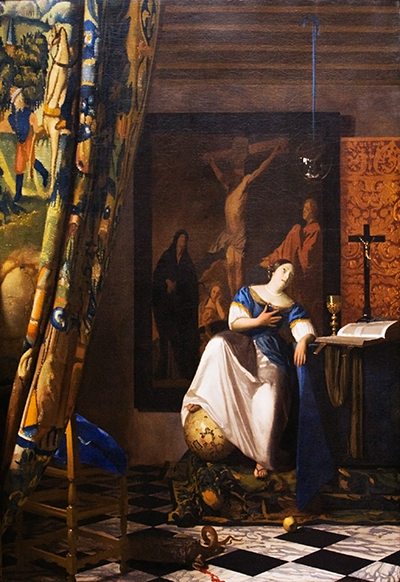The Allegory of Faith manifests a coveted frontier for Vermeer as he showcases a religious illustration of the middleclass society in the Netherlands.
Similar artworks holding a religious context to the Allegory of Faith include Christ in the House of Martha and Mary, and Diana and her Companions.
Johannes Vermeer is a Dutch artist well known for his Baroque artwork that steps into the unknown and transcends the history of art.
The 1670's painting intertwines religious elements with an array of architecture adding to the brilliance of the painting. Allegory of Faith showcases a woman in a white satin dress with gold trimmings and a blue veil that she holds in one hand. The woman tilts her body back, placing her other hand on her heart as she looks out towards the crucifix above her to the right.
The woman's mouth is slightly open as she is in awe of the religious symbol. The interesting format of the woman is amplified as she places her right leg on top of a round globe that is seated on the floor.
The woman is placed on top of a small alter covered in shades of green and gold. The remainder of the artwork is as captivating as the woman seized by the religious symbol.
A blue string hangs from the ceiling of the room with a round glass light. The viewer is able to recognize the room from prior paintings of Vermeer as the classic checker tiles on the floor and mosaic window on the life is evident in Lady Writing a Letter With Her Maid, The Music Lesson, and The Art of Painting. These brilliant artworks are based in the same interior in which the artist based most of his art.
The room holds signature gold pieces throughout the room reflecting on the artist's exploration in the Baroque style. This technique adds drama and emotion to the artwork, adding more drama to the painting.
An artist with a similar style who up rose in a few centuries after Vermeer is Austrian painter Gustav Klimt. The artist incorporated an array of gold shades throughout his art that added a metallic feel and coined his work as the Gold Phase.
The dramatic architecture and interior styling of the room adds composition to the painting as it is covered in a multitude of items. A provoking colourful curtain is showcased to the left the painting covered in outdoor scenery.
A bright colour scheme on the curtain is used with deep shades of burnt orange, teal blue, classic beige and an array of greens. The floor is covered in the classic white and black checker tile the artist most commonly painted. A wooden chair is placed near the left section of the painting covered in a dark blue cloak.
The final eye catching accessory located within the artwork is the Catholic painting placed against the grand wall. The painting within seems to showcase the crucifixion of Christ.
The captivating painting continues the theme of the death of Jesus, as the woman holds her hand against her heart pondering the difficult moment. The religious painting offers an altered concept illustrated throughout Vermeer's work.




